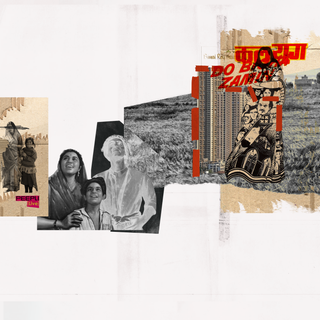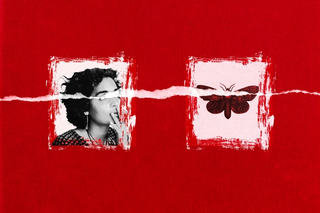
We're Reading Arundhati Roy Badly
'Mother Mary Comes To Me' is the ultimate literary souvenir for urban upper-middle-class India. Perhaps it is no surprise, then, that it is being read incompletely.

You don’t have to read Mother Mary Comes To Me to take in the force of Arundhati Roy’s literary enterprise. The physical copy of the book is spectacle enough: Its hardback, clothbound red cover; its dust jacket, with Roy smoking a cigarette, indisputably à la mode; its smooth, thick paper, the custom bookmark. Much of the cheer around the memoir fusses over its beauty and lavish production. Conveniently overlooked are two clear influences on the design: the Holy Bible, invoked by the title’s scriptural play, and The Communist Manifesto, the bright red cover an impish nod to the writer’s politics.
Roy (and, by extension, her memoir) plays two contradictory roles in contemporary India: literary god and political renegade. It is telling which self her readers and critics have chosen to sanctify.
Mother Mary Comes To Me is the ultimate literary souvenir for urban upper-middle-class India. Perhaps it is no surprise, then, that it is being read incompletely. Critical attention skirts the memoir’s political overtones, leaving them unscrutinized, raving instead about its stylistic flourishes and Roy’s relationship with her zany mother. Reading one of the country’s most political writers as an un-partisan figure is a mayday call for criticism and literature in Modi-era India.
For Roy, her literary and political work are one and the same.
While promoting her memoir, Roy has been speaking of politics above all, lampooning Narendra Modi, critiquing the normalized impunity of Israel’s Prime Minister Benjamin Netanyahu, and even noting the ever-growing dalliance between Hindutva and Zionism. As a writer, she has decidedly tendentious preoccupations. Arundhati Roy is not, and has never been, a universal author.
In Amit Chaudhuri’s review of the memoir, he writes, “These pages aren’t… a preamble to her life as a bestselling writer who would go on to become an oppositional political voice.” He assures readers that, “Even if [Roy] were none of these things… [the book] would be utterly absorbing.” Chaudhuri disregards why Roy might have entrusted her life story to help readers understand her politics. Claiming that the book would read well even without the context of her insubordinate oeuvre is to discount her life’s activism. Readers turn to writers’ memoirs to reckon with who a writer is and how they became so. By insisting that Roy’s memoir is not a preamble to her politics, Chaudhuri only shows how he’s misread her as a writer.
Roy says as much in her book. Talking about how the compound noun “writer-activist,” often attributed to her, rankles her, she writes with thinly veiled exasperation: “A term I found absurd because it suggested that writing about things that vitally affected people’s lives was not the remit of a writer. That needed an additional appellation. To me, ‘writer-activist’ sounded a bit like a sofa-bed.” For Roy, her literary and political work are one and the same.
Other critics similarly circumvent Roy’s politics. Most focus only on her dynamic with her frazzled mother, with one even peeved when the memoir veers into Roy’s activism: “I was impatient when she veered off to bigger things in life, to Narmada to stop the contentious dam, through woods with the hated Maoists, to a day in jail for repeatedly ‘contempting’ the court…” Another notes, “The book’s more remarkable passages are not about literary destiny or court cases; they are about texture and weather, how loss alters light in a room, the silence flaring after a slammed door,” even placing Roy in the “canon of grief literature,” alongside Joan Didion and Patti Smith, whose works carry none of her political urgency.
The critics aren’t wrong about her current book being an interrogation of the relationship between mothers and daughters. But in reading Roy in part, they inadvertently conjure a spectral image of her that is neutered and polished.
This is not the first time Roy has been met with such a fate. Although post-independence Indians wanted to celebrate her international win with The God of Small Things, to do so “wholeheartedly,” she writes, they “needed [it] to be de-politicized.” Over the years that followed the Booker win, a book that invited much chagrin – including charges of obscenity and even the threat of a ban – was filched of everything it set out to problematise. Its critique of caste politics and its suspicion of the secularism promised by communist politics were spurned. Instead, the novel was lauded for its singular style.
The critics aren’t wrong about her current book being an interrogation of the relationship between mothers and daughters. But in reading Roy in part, they inadvertently conjure a spectral image of her that is neutered and polished. Roy, if we’re to believe these critics, is only compelling as long as she isn’t politicking. This selective reading constructs a defanged and graceful Roy: one who preens about her mother, her childhood, and her literary career, dodging the sharp political commentary that has always accompanied her prose. The structure of Mother Mary Comes To Me – which reads like a curious Frankenstein of two books with seemingly unallied concerns, her mother and her country – unfortunately lets readers get away with moulting her.
There was a time in India when Roy was polarising for the urban middle class, a period in which she “made... a whole lot of enemies.” As an essayist, she miffed everyone from Delhi elites to the state and a caucus of lawyers. Her notoriety escalated when The God of Small Things won the Booker Prize in 1997, lifting her first to fame and then to infamy. Upon publishing her first political essay, “The End of Imagination,” in which she prophetically decried India’s 1998 nuclear tests, Roy was “kicked off [her] literary-star, fairy-princess pedestal.” Now that she had disappointed the class, nothing could stop her from writing what she wanted to, not to mention that she had racked up enough royalties to flout approval entirely. Even after years of fame and controversy, she writes as though unchanged. As the mettlesome writer she has always been.
The memoir is less about Roy’s fraught relationship with her ill-tempered, prodigious mother, and more about the kind of daughter her mother brought up – even if, sometimes, unwillingly.
Roy’s memoir is heartbreakingly alert to India’s social and political crises. In it, she is many graceless and graceful selves: petty, angry, grieving, and entirely readable. Long branded an “urban naxal” – a label rationed to left-leaning intellectuals and activists who parry with the draconian state – she explains herself in the memoir: her tempestuous marriages, her foray into political writing, her excursions with the Bastar naxalites, her love for her beau monde friends, and her entitlement to a plush life.
Naturally, the memoir is flush with references to her novels as well as essays like “Professor POW,” in which she lambasts the court that unfairly treated Professor G. N. Saibaba during his incarceration, and “The Great Indian Rape-Trick,” in which she pillories Bandit Queen, a film about Phoolan Devi, questioning the director’s right to “restage the rape of a living woman without her permission.” She tips us off to her process and foretells her reception. The memoir is less about Roy’s fraught relationship with her ill-tempered, prodigious mother, and more about the kind of daughter her mother brought up – even if, sometimes, unwillingly.
What Roy tacitly concedes is that her odyssey as a writer runs parallel to India’s own as a state. Through her mother, who too fought her battles with brass tacks, Roy places herself in a lineage of resistance. It is, then, intriguing that her readers would rather see in her a figure of reconciliation, fulfilling the putative task of the contemporary female novelist – to simply make sense of her relationship with her mother. Roy, whether the urban middle class likes it or not, is characteristically much more.
The polemical interludes of Roy’s memoir have the potential to break the stasis haunting India’s liberal polity, a polity that prefers to remain unquestioned and, most of all, undisturbed under Modi 3.0. By championing Roy as an apolitical, universal, grieving daughter-writer, the urban upper-middle class signal a preference for her intimate, daughterly perspective over her critique of the nation. After all, it is the only way to be a “safe” reader in this country. In a state bent on centralization, where protest teeters on the brink of marginalization and writing and reporting have begun to self-neuter, the only way to reckon with art is to virtuously insist that a book is more than its movement. Urban middle-class readers prefer Roy as a universal “daughter-writer,” not as an “urban naxal” or political critic. Even she cannot afford to be both.
A leftist independent publisher once flicked his cigarette and remarked to me, “Arundhati has an unabashed hatred for the communist project,” a line he has surely repeated many times. Even for him, Roy’s book offers a riposte: “I was denounced as anti-communist (though nothing could be further from the truth)…” The memoir, in part, asserts her control over these misreadings, challenging labels that have long sought to obscure her political identity in favour of the innocuous, literary one.
Roy’s second novel, The Ministry of Utmost Happiness, is perhaps a response to her apolitical readers divorcing her fiction from her non-fiction, as if to clarify her politics once and for all. In it, she scours the grisliest crises imperiling her nation – communal violence, bureaucratic corruption, displacement, and gendered oppression – subjects she had previously addressed only in individual essays. The criticism that followed predictably separated politics from stylistics, with one reviewer even trumpeting that “Arundhati Roy the Activist has won over Arundhati Roy the Novelist,” noting how the novel “marks the end of imagination for Arundhati Roy as a novelist.”
The reception of Roy’s memoir exposes a hunger for icons stripped of politics, with the cost being an even more weakened public discourse. In the aversion to imaginative dissent, the collateral damage is writers who dispute orthodoxies, and readers willing to confront agonizing actualities about the nation.
On the first page of her memoir, Roy dedicates the book to her brother and her mother, for whom she writes, “For Mary Roy, Who never said Let It Be.” It’s both a reference to the Beatles song from which Roy borrowed the title and her mother’s politics – a refusal to accept complacency – that Roy inherited.
To incompletely read Roy is to misread her entirely.
Diya Isha is a writer based in New Delhi and an editorial staffer at The Swaddle. She is on Instagram @contendish.
Related


On 'Newstrack,' or Digital News Before Digital News
